stop start VOLVO XC90 TWIN ENGINE 2019 User Guide
[x] Cancel search | Manufacturer: VOLVO, Model Year: 2019, Model line: XC90 TWIN ENGINE, Model: VOLVO XC90 TWIN ENGINE 2019Pages: 697, PDF Size: 10.33 MB
Page 234 of 697
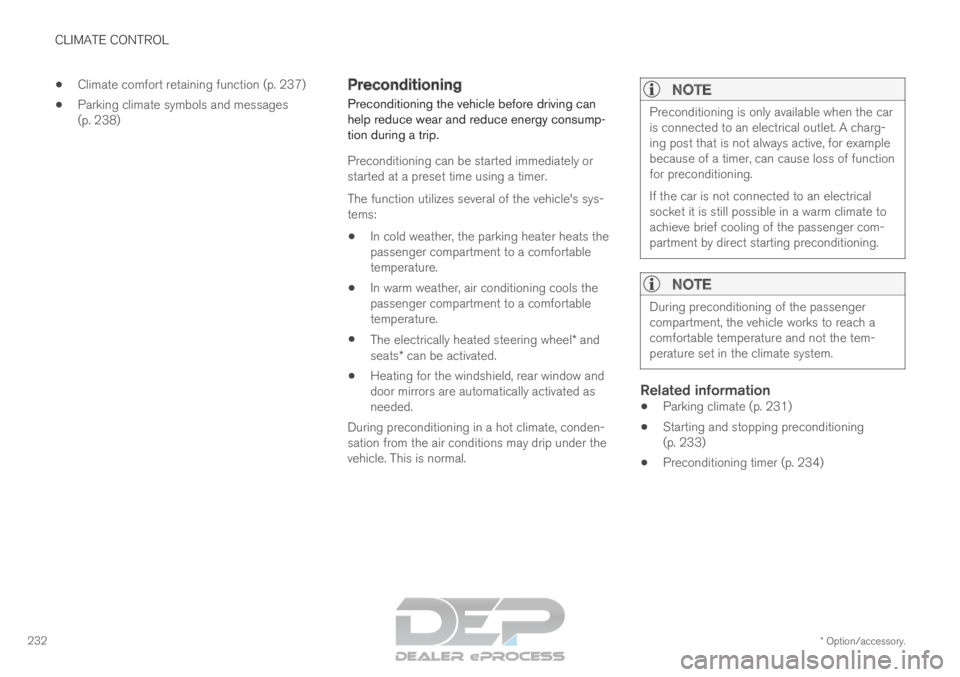
CLIMATE CONTROL
* Option/accessory.
232
Climate comfort retaining function (p. 237)
Parking climate symbols and messages
(p. 238) Preconditioning
Preconditioning the vehicle before driving can
help reduce wear and reduce energy consump-
tion during a trip.
Preconditioning can be started immediately or
started at a preset time using a timer.
The function utilizes several of the vehicle's sys-
tems: In cold weather, the parking heater heats the
passenger compartment to a comfortable
temperature.
In warm weather, air conditioning cools the
passenger compartment to a comfortable
temperature.
The electrically heated steering wheel* and
seats* can be activated.
Heating for the windshield, rear window and
door mirrors are automatically activated as
needed.
During preconditioning in a hot climate, conden-
sation from the air conditions may drip under the
vehicle. This is normal.
NOTE Preconditioning is only available when the car
is connected to an electrical outlet. A charg-
ing post that is not always active, for example
because of a timer, can cause loss of function
for preconditioning.
If the car is not connected to an electrical
socket it is still possible in a warm climate to
achieve brief cooling of the passenger com-
partment by direct starting preconditioning.
NOTE
During preconditioning of the passenger
compartment, the vehicle works to reach a
comfortable temperature and not the tem-
perature set in the climate system.
Related information
Parking climate (p. 231)
Starting and stopping preconditioning
(p. 233)
Preconditioning timer (p. 234)
Page 235 of 697
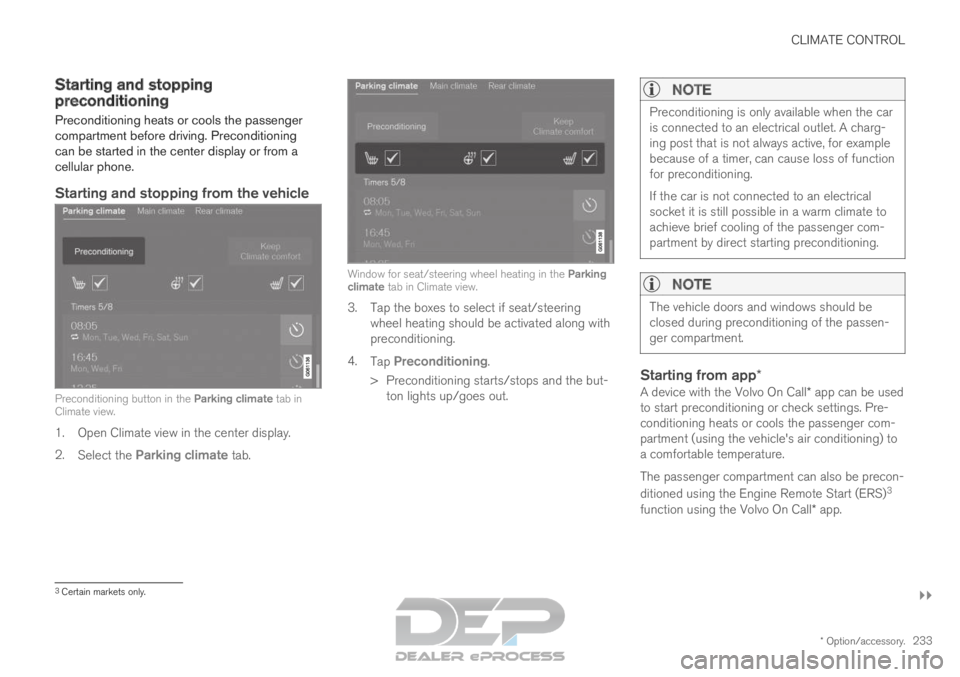
CLIMATE CONTROL
}}
* Option/accessory. 233
Starting and stopping
preconditioning
Preconditioning heats or cools the passenger
compartment before driving. Preconditioning
can be started in the center display or from a
cellular phone.
Starting and stopping from the vehicle Preconditioning button in the Parking climate tab in
Climate view.
1. Open Climate view in the center display.
2. Select the Parking climate tab. Window for seat/steering wheel heating in the Parking
climate tab in Climate view.
3. Tap the boxes to select if seat/steering
wheel heating should be activated along with
preconditioning.
4. Tap Preconditioning.
>
Preconditioning starts/stops and the but-
ton lights up/goes out.
NOTE Preconditioning is only available when the car
is connected to an electrical outlet. A charg-
ing post that is not always active, for example
because of a timer, can cause loss of function
for preconditioning.
If the car is not connected to an electrical
socket it is still possible in a warm climate to
achieve brief cooling of the passenger com-
partment by direct starting preconditioning.
NOTE
The vehicle doors and windows should be
closed during preconditioning of the passen-
ger compartment.
Starting from app*
A device with the Volvo On Call* app can be used
to start preconditioning or check settings. Pre-
conditioning heats or cools the passenger com-
partment (using the vehicle's air conditioning) to
a comfortable temperature.
The passenger compartment can also be precon-
ditioned using the Engine Remote Start (ERS) 3
function using the Volvo On Call* app. 3
Certain markets only.
Page 257 of 697
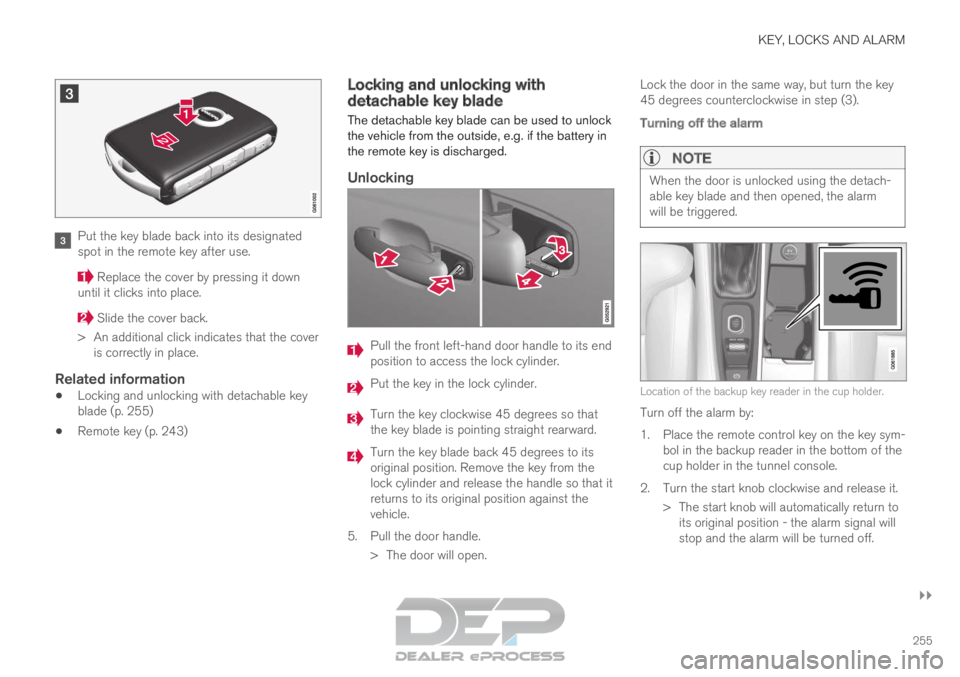
KEY, LOCKS AND ALARM
}}
255 Put the key blade back into its designated
spot in the remote key after use.
Replace the cover by pressing it down
until it clicks into place. Slide the cover back.
>
An additional click indicates that the cover
is correctly in place.
Related information
Locking and unlocking with detachable key
blade (p. 255)
Remote key (p. 243) Locking and unlocking with
detachable key blade
The detachable key blade can be used to unlock
the vehicle from the outside, e.g. if the battery in
the remote key is discharged.
Unlocking Pull the front left-hand door handle to its end
position to access the lock cylinder.
Put the key in the lock cylinder.
Turn the key clockwise 45 degrees so that
the key blade is pointing straight rearward.
Turn the key blade back 45 degrees to its
original position. Remove the key from the
lock cylinder and release the handle so that it
returns to its original position against the
vehicle.
5.
Pull the door handle.
> The door will open. Lock the door in the same way, but turn the key
45 degrees counterclockwise in step (3).
Turning off the alarm
NOTE When the door is unlocked using the detach-
able key blade and then opened, the alarm
will be triggered.
Location of the backup key reader in the cup holder.
Turn off the alarm by:
1.
Place the remote control key on the key sym-
bol in the backup reader in the bottom of the
cup holder in the tunnel console.
2. Turn the start knob clockwise and release it. > The start knob will automatically return toits original position - the alarm signal will
stop and the alarm will be turned off.
Page 284 of 697
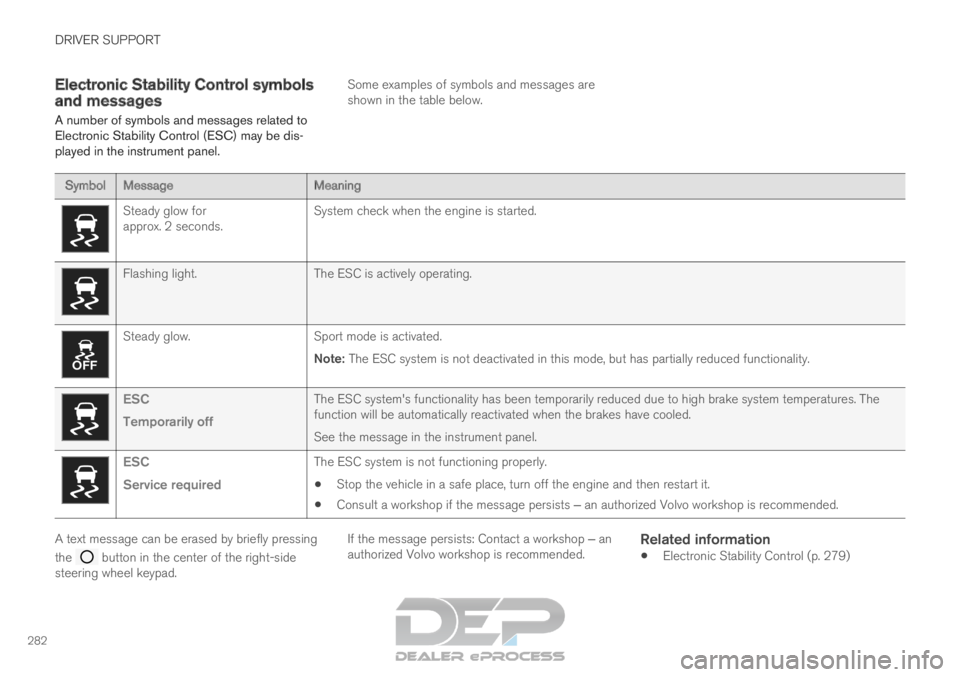
DRIVER SUPPORT
282Electronic Stability Control symbols
and messages
A number of symbols and messages related to
Electronic Stability Control (ESC) may be dis-
played in the instrument panel. Some examples of symbols and messages are
shown in the table below.Symbol
Message MeaningSteady glow for
approx. 2 seconds.
System check when the engine is started.Flashing light.
The ESC is actively operating.Steady glow.
Sport mode is activated.
Note: The ESC system is not deactivated in this mode, but has partially reduc\
ed functionality. ESC
Temporarily off
The ESC system's functionality has been temporarily reduced due to hi\
gh brake system temperatures. The
function will be automatically reactivated when the brakes have cooled.
See the message in the instrument panel.ESC
Service required
The ESC system is not functioning properly.
Stop the vehicle in a safe place, turn off the engine and then restart i\
t.
Consult a workshop if the message persists ‒ an authorized Volvo workshop is recommended. A text message can be erased by briefly pressing
the
button in the center of the right-side
steering wheel keypad. If the message persists: Contact a workshop ‒ an
authorized Volvo workshop is recommended.
Related information
Electronic Stability Control (p. 279)
Page 410 of 697

DRIVER SUPPORT
408Parking with Park Assist Pilot
Park Assist Pilot (PAP 124
) helps the driver park
using three different steps. The function can also
help the driver pull out of a parking space.
NOTE The PAP function measures the space and
steers the vehicle – the driver's role is to:
keep close watch of the area around the
vehicle
follow the instructions on the center dis-
play
change gears (reverse/forward) – a
"ping" sound indicates when the driver
should change gears
regulate and maintain a safe speed
apply the brakes and stop. Information about the actions required by the
driver are provided in the center display using
symbols, graphics and/or text.
PAP can be activated if the following criteria have
been met after the engine is started:
No trailer is hitched to the vehicle
Your vehicle's speed is lower than 30 km/h
(20 mph).
NOTE The distance between the vehicle and parking
spots should be 0.5-1.5 meters (1.6-5.0 ft)
when PAP is looking for parking.
ParkingPAP parks the vehicle using the following steps:
1. The system searches for and measures
potential parking spaces.
2. The vehicle is steered while it is backing into the parking space.
3. The vehicle is positioned in the parking space (the driver may be prompted to shift
gears).
Searching for and measuring potential
parking spots
The function can be activated
in the center display's Function
view.
It can also be accessed from
the camera views. Parallel parking overview.
Perpendicular parking overview.
To do so: 124
Park Assist Pilot
Page 418 of 697
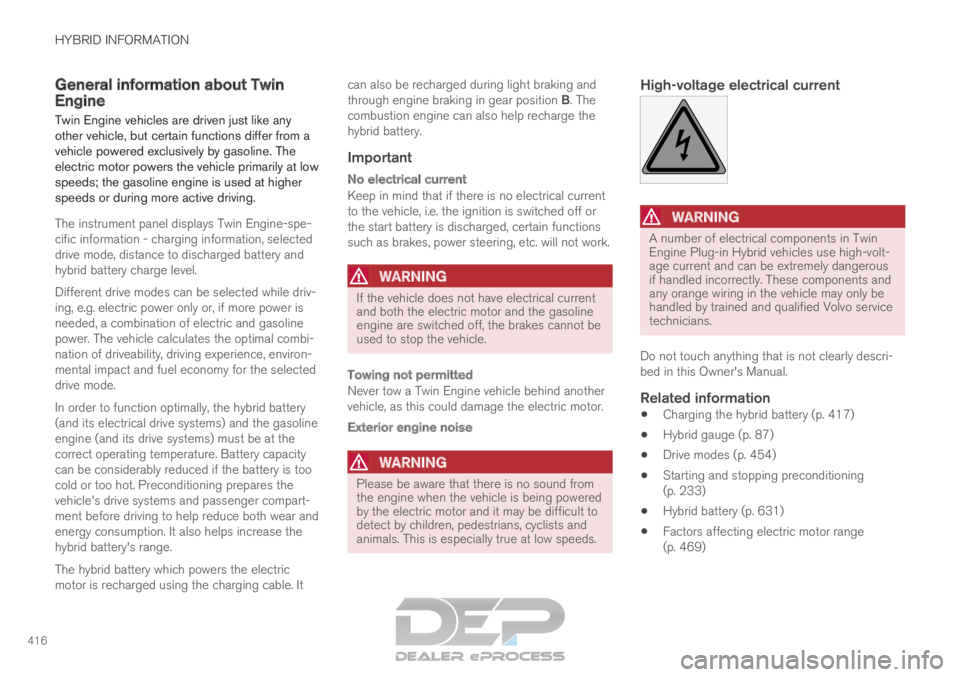
HYBRID INFORMATION
416General information about Twin
Engine
Twin Engine vehicles are driven just like any
other vehicle, but certain functions differ from a
vehicle powered exclusively by gasoline. The
electric motor powers the vehicle primarily at low
speeds; the gasoline engine is used at higher
speeds or during more active driving.
The instrument panel displays Twin Engine-spe-
cific information - charging information, selected
drive mode, distance to discharged battery and
hybrid battery charge level.
Different drive modes can be selected while driv-
ing, e.g. electric power only or, if more power is
needed, a combination of electric and gasoline
power. The vehicle calculates the optimal combi-
nation of driveability, driving experience, environ-
mental impact and fuel economy for the selected
drive mode.
In order to function optimally, the hybrid battery
(and its electrical drive systems) and the gasoline
engine (and its drive systems) must be at the
correct operating temperature. Battery capacity
can be considerably reduced if the battery is too
cold or too hot. Preconditioning prepares the
vehicle's drive systems and passenger compart-
ment before driving to help reduce both wear and
energy consumption. It also helps increase the
hybrid battery's range.
The hybrid battery which powers the electric
motor is recharged using the charging cable. It can also be recharged during light braking and
through engine braking in gear position B. The
combustion engine can also help recharge the
hybrid battery.
Important
No electrical current
Keep in mind that if there is no electrical current
to the vehicle, i.e. the ignition is switched off or
the start battery is discharged, certain functions
such as brakes, power steering, etc. will not work.
WARNING If the vehicle does not have electrical current
and both the electric motor and the gasoline
engine are switched off, the brakes cannot be
used to stop the vehicle.
Towing not permitted
Never tow a Twin Engine vehicle behind another
vehicle, as this could damage the electric motor.
Exterior engine noise
WARNING
Please be aware that there is no sound from
the engine when the vehicle is being powered
by the electric motor and it may be difficult to
detect by children, pedestrians, cyclists and
animals. This is especially true at low speeds.
High-voltage electrical current
WARNING A number of electrical components in Twin
Engine Plug-in Hybrid vehicles use high-volt-
age current and can be extremely dangerous
if handled incorrectly. These components and
any orange wiring in the vehicle may only be
handled by trained and qualified Volvo service
technicians.
Do not touch anything that is not clearly descri-
bed in this Owner's Manual.
Related information
Charging the hybrid battery (p. 417)
Hybrid gauge (p. 87)
Drive modes (p. 454)
Starting and stopping preconditioning
(p. 233)
Hybrid battery (p. 631)
Factors affecting electric motor range
(p. 469)
Page 420 of 697
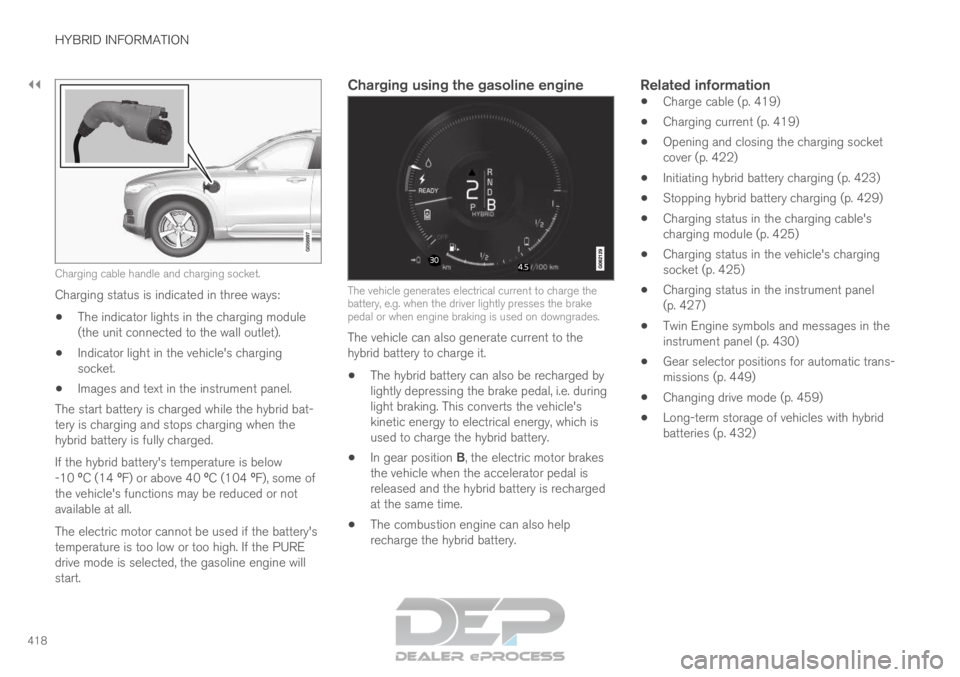
||HYBRID INFORMATION
418
Charging cable handle and charging socket.
Charging status is indicated in three ways:
The indicator lights in the charging module
(the unit connected to the wall outlet).
Indicator light in the vehicle's charging
socket.
Images and text in the instrument panel.
The start battery is charged while the hybrid bat-
tery is charging and stops charging when the
hybrid battery is fully charged.
If the hybrid battery's temperature is below
-10 ºC (14 ºF) or above 40 ºC (104 ºF), some of
the vehicle's functions may be reduced or not
available at all.
The electric motor cannot be used if the battery's
temperature is too low or too high. If the PURE
drive mode is selected, the gasoline engine will
start.
Charging using the gasoline engine The vehicle generates electrical current to charge the
battery, e.g. when the driver lightly presses the brake
pedal or when engine braking is used on downgrades.
The vehicle can also generate current to the
hybrid battery to charge it.
The hybrid battery can also be recharged by
lightly depressing the brake pedal, i.e. during
light braking. This converts the vehicle's
kinetic energy to electrical energy, which is
used to charge the hybrid battery.
In gear position B, the electric motor brakes
the vehicle when the accelerator pedal is
released and the hybrid battery is recharged
at the same time.
The combustion engine can also help
recharge the hybrid battery.Related information
Charge cable (p. 419)
Charging current (p. 419)
Opening and closing the charging socket
cover (p. 422)
Initiating hybrid battery charging (p. 423)
Stopping hybrid battery charging (p. 429)
Charging status in the charging cable's
charging module (p. 425)
Charging status in the vehicle's charging
socket (p. 425)
Charging status in the instrument panel
(p. 427)
Twin Engine symbols and messages in the
instrument panel (p. 430)
Gear selector positions for automatic trans-
missions (p. 449)
Changing drive mode (p. 459)
Long-term storage of vehicles with hybrid
batteries (p. 432)
Page 421 of 697

HYBRID INFORMATION
}}
419
Charging current
Charging current is used to charge the hybrid
battery and precondition the vehicle. Charging is
performed by connecting a charging cable
between the vehicle's charging socket and a
120/240 V electrical socket (alternating cur-
rent).
When the charging cable is activated, a message
will be displayed in the instrument panel and an
indicator light in the vehicle's charging socket will
illuminate. Charging current is primarily used for
battery charging, but is also used for precondi-
tioning. The vehicle's start battery is charged
along with the hybrid battery.
CAUTION
Never detach the charging cable from the
120/240 V outlet (AC, alternating current)
while charging is in progress – the
120/240 V outlet could be damaged in such
circumstances. Always interrupt charging first
and then disconnect the charging cable – first
from the vehicle's charging socket and then
from the 120/240 V outlet.
NOTE
In extremely cold or hot weather, part of
the charging current is used to heat/cool
the hybrid battery and the passenger
compartment, resulting in a longer charg-
ing time.
The charging time is longer if precondi-
tioning has been selected. The time
required depends primarily on the ambi-
ent temperature.
FuseThere are normally several 120/240 V power
consumers in one fuse circuit, which means that
more than one power consumer (e.g. lighting,
vacuum cleaner, electric drill, etc.) may use the
same fuse.
Related information
Charge cable (p. 419)
Charging status in the instrument panel
(p. 427)
Charging status in the vehicle's charging
socket (p. 425)
Starting and stopping preconditioning
(p. 233)
Stopping hybrid battery charging (p. 429) Charge cable
The charging cable is used to recharge your
vehicle's hybrid battery.
The charging cable is stored in a storage compartment
under the cargo compartment floor.
WARNING
Only use the charging cable provided with
your vehicle or a replacement cable pur-
chased from a Volvo retailer.
Specifications, charging cable
Compliance
SAE J1772
Ambient tempera-
ture -32 ºC to 50 ºC (-25 º
F
till 122 ºF)
Page 426 of 697

||HYBRID INFORMATION
424
Open the charger door and remove the
charging socket's protective cover. Push the
charging handle all the way into the vehicle's
socket.
3.
The charging cable handle will lock into
place and charging will begin within
5 seconds. When charging starts, the green
LED light in the charging socket will begin to
flash. The approximate remaining charging
time or the charging status will be displayed
in the instrument panel.
Charging may be temporarily interrupted if
the vehicle is unlocked:
and a door is open ‒ charging will restart
within a few minutes.
if no door is opened ‒ the vehicle will
automatically relock. Charging will resume
after 1 minute.
CAUTION Never detach the charging cable from the
120/240 V outlet (AC, alternating current)
while charging is in progress – the
120/240 V outlet could be damaged in such
circumstances. Always interrupt charging first
and then disconnect the charging cable – first
from the vehicle's charging socket and then
from the 120/240 V outlet.
During charging, condensation from the air con-
ditioning may form under the vehicle. This is nor-
mal and is caused by the hybrid battery cooling.
Related information
Charging the hybrid battery (p. 417)
Opening and closing the charging socket
cover (p. 422)
Charging status in the vehicle's charging
socket (p. 425)
Charging status in the instrument panel
(p. 427)
Charging status in the charging cable's
charging module (p. 425)
Stopping hybrid battery charging (p. 429)
Page 427 of 697

HYBRID INFORMATION
}}
425
Charging status in the vehicle's
charging socket
The charging status is indicated by an LED light
in the charging socket. Location of the LED indicator light in the vehicle's
charging socket.
The LED indicator light shows the current charge
status during charging. If the LED indicator light
is not illuminated, check to make sure the cable
is securely connected in the wall outlet and in the
outlet in the vehicle. A white, red or yellow light
illuminates when the passenger compartment
lighting is activated and will remain illuminated for
a short time after the passenger compartment
lighting has gone out. LED indicator
light's color
Meaning
White
Courtesy light.
Yellow Wait modeA
– waiting for
charging to start.
Flashing green Charging is in progress B
.
Green Charging completed C
.
Red Malfunction. A
E.g. after a door has been opened or if the charging cable han-
dle is not locked in place.
B The more slowly the light flashes, the closer the battery is to
being fully charged.
C The light will go out after a short time.
Related information
Charging the hybrid battery (p. 417)
Charging status in the instrument panel
(p. 427)
Charging status in the charging cable's
charging module (p. 425)
Stopping hybrid battery charging (p. 429) Charging status in the charging
cable's charging module
The red and blue lights in the charging module
indicate the status of ongoing and completed
charging. Charge module: 1. Red warning light, 2. Blue status indi-
cator
When the charge module is initially plugged into
a wall outlet, the red warning light will flash once
to indicate that a startup safety check has been
performed. When the safety check has been
completed, the blue status indicator will glow
steadily and the red warning light will be off. The
charger is now ready to be used. If the red warn-
ing light continues to flash or glows steadily, a
fault has been detected and the charger will not
deliver power to the vehicle. Contact a Volvo
retailer or a certified Volvo service technician.